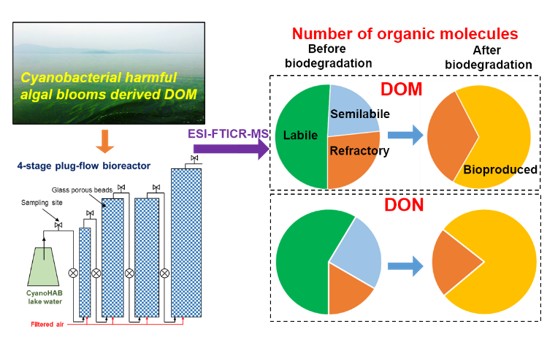Progress Made on Quick Detection and Quantitative Understanding of Bio-availability of Lake Dissolved Organic Matter
The cyanobacteria bloom caused by the lake eutrophication leads to the generation of a large amount of algal dissolved organic matters (DOM), which affects the environment action of lake pollutants and affects the biogeochemical process of the lake system. The bio-availability is one of the significant features of DOM, which is closely related to carbon-nitrogen cycle, replacement of biological community structures and the degradation of emerging organic pollutants. However, the traditional detection technology for DOM bio-availability, namely biological inoculation method, requires a long time and is not convenient for the analysis of features of active, semi-active and refractory components of DOM.
Researchers including Dr. Bai Leilei of the topic group “River and Dragon” of Nanjing Institute of Geography and Limnology designed a 4-Stage Plug-Flow Bioreactor on their own for the quick detection of DOM bio-availability. Compared with common biological inoculation method, such biology detection device is able to achieve a DOM degradation rate within 4 days that requires 56 days by the traditional inoculation method. In addition, it can also be used for analyzing the relationships between DOM components and the characteristics of the degraded microorganism communities.
It is found by the 4-Stage Plug-Flow Bioreactor that the active and semi-active components of the algal DOM account for 79%, while the refractory components cannot be ignored. The active component of DOM is reverse to the diversity of the degraded bacteria communities; the refractory components can increase the diversity of the microorganism communities. Through the three-dimensional fluorescence-parallel factors analysis, high-performance liquid chromatography-three-dimensional fluorescence and ESI-FTICR-MS technology, it is indicated that the bio-activity of hydrophilic humus matters is weaker than that of hydrophobic humus matters. DOM molecules with low aromaticity, high oxidation and more nitrogen are easily to be used by the microorganisms, which will be degraded to lipid substance. The main refractory component is rich carboxyl alicyclic molecule. In addition, it is found by the research that the degradation of the algal dissolved organic matters causes the categories of the refractory nitrogen molecule to increase to 4 times, which strongly affects the components of the organic nitrogen in the lake.
The achievements of this research improves the efficiency of the analysis of DOM bio-availability and enhances the knowledge of the environment action and trends of DOM in the lake as well as its environmental and ecological effects. The above achievement is published on-line on the mainstream scientific periodicals Environmental Science and Technology with a title of “Toward Quantitative Understanding of the Bioavailability of Dissolved Organic Matter in Freshwater Lake during Cyanobacteria Blooming”. This research is funded by the Natural Science Foundation of China and Innovative and Cross-functional Team of Chines Academy of Sciences.
Link to the essay: http://pubs.acs.org/doi/abs/10.1021/acs.est.7b00826

Analysis on Bio-availability of Dissolved Organisms and Changes of Molecule Categories of Refractory Organic Matters (including the organic nitrogen) During Taihu Cyanobacteria Bloom (Image by NIGLAS)
